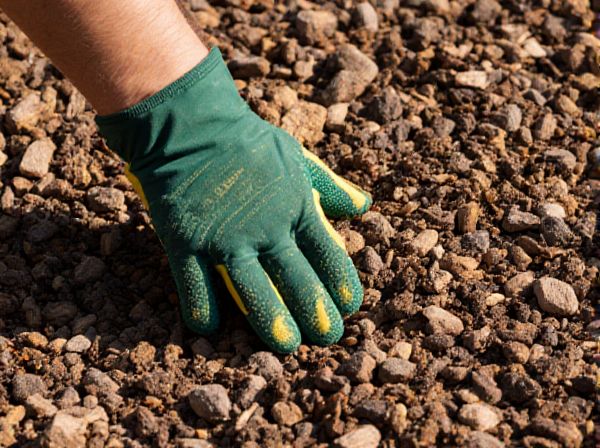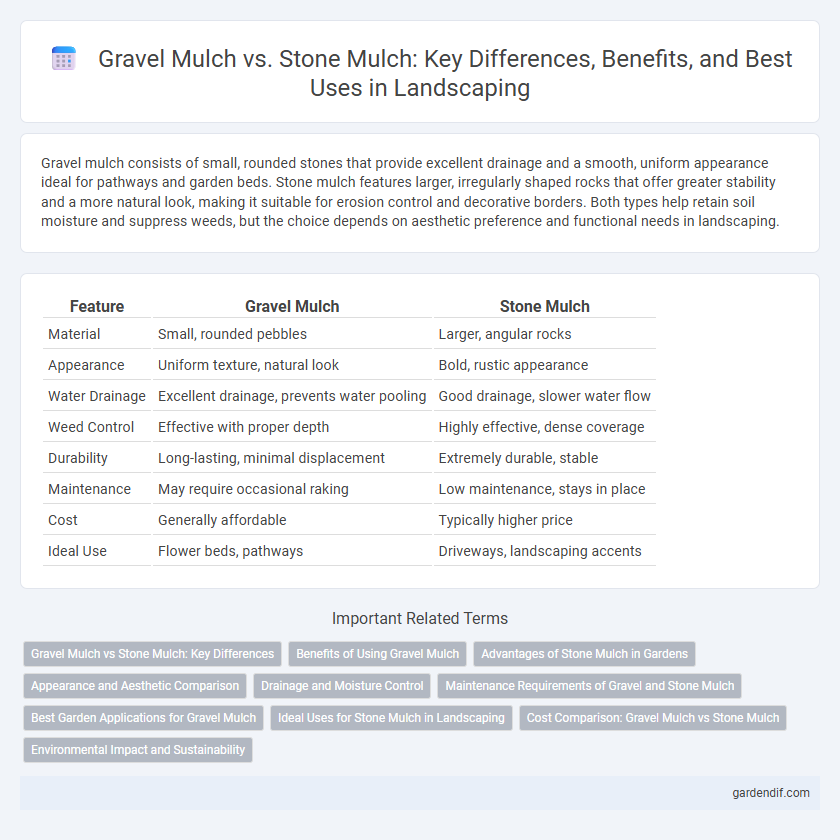
Gravel mulch vs Stone mulch Illustration
Gravel mulch consists of small, rounded stones that provide excellent drainage and a smooth, uniform appearance ideal for pathways and garden beds. Stone mulch features larger, irregularly shaped rocks that offer greater stability and a more natural look, making it suitable for erosion control and decorative borders. Both types help retain soil moisture and suppress weeds, but the choice depends on aesthetic preference and functional needs in landscaping.
Table of Comparison
| Feature | Gravel Mulch | Stone Mulch |
|---|---|---|
| Material | Small, rounded pebbles | Larger, angular rocks |
| Appearance | Uniform texture, natural look | Bold, rustic appearance |
| Water Drainage | Excellent drainage, prevents water pooling | Good drainage, slower water flow |
| Weed Control | Effective with proper depth | Highly effective, dense coverage |
| Durability | Long-lasting, minimal displacement | Extremely durable, stable |
| Maintenance | May require occasional raking | Low maintenance, stays in place |
| Cost | Generally affordable | Typically higher price |
| Ideal Use | Flower beds, pathways | Driveways, landscaping accents |
Gravel Mulch vs Stone Mulch: Key Differences
Gravel mulch consists of small, smooth, and rounded particles typically 2-10 mm in diameter, promoting good drainage and minimizing soil compaction, while stone mulch features larger, irregular, and often sharp-edged rocks that provide heavier ground coverage and longevity. Gravel mulch is ideal for decorative pathways and garden beds requiring aeration, whereas stone mulch excels in weed suppression and erosion control due to its mass and stability. Both types differ in cost, installation effort, and maintenance needs, with gravel being easier to spread and replace and stone offering more durability over time.
Benefits of Using Gravel Mulch
Gravel mulch enhances soil moisture retention and temperature regulation, promoting healthier plant growth compared to stone mulch. Its porous nature improves drainage and prevents soil erosion, while also deterring weed growth without compacting the soil. This versatile mulch option requires minimal maintenance and adds an aesthetically pleasing natural texture to garden landscapes.
Advantages of Stone Mulch in Gardens
Stone mulch offers superior durability and long-lasting coverage compared to gravel mulch, reducing the need for frequent replacement. Its heavier weight helps prevent soil erosion and suppresses weed growth more effectively, maintaining a cleaner garden environment. Additionally, stone mulch enhances soil moisture retention by minimizing evaporation while providing a natural aesthetic appeal that complements various landscape designs.
Appearance and Aesthetic Comparison
Gravel mulch offers a uniform, smooth texture with smaller, rounded stones that create a sleek and modern look ideal for minimalist garden designs. Stone mulch consists of larger, more irregular rocks that add a rugged, natural aesthetic, often enhancing rustic or Mediterranean landscapes. Both mulches improve soil moisture retention and weed control while providing distinct visual appeal tailored to specific garden styles.
Drainage and Moisture Control
Gravel mulch offers superior drainage compared to stone mulch due to its smaller particle size, which allows water to permeate quickly and reduces the risk of water pooling around plant roots. Stone mulch, with larger, denser pieces, tends to retain moisture longer, making it beneficial for landscapes requiring sustained soil hydration. Both mulches contribute to moisture control, but gravel mulch is preferred in areas prone to heavy rainfall to prevent soil erosion and root rot.
Maintenance Requirements of Gravel and Stone Mulch
Gravel mulch requires periodic raking to prevent compaction and occasional topping up to maintain an even layer, while stone mulch demands less frequent upkeep due to its larger size and resistance to displacement. Both materials benefit from weed barrier installation to minimize weed growth, but stone mulch's heavier weight makes it less prone to wind-blown scattering. Proper maintenance of gravel and stone mulch ensures effective moisture retention and soil temperature regulation in landscape applications.
Best Garden Applications for Gravel Mulch
Gravel mulch is ideal for garden beds that require excellent drainage and weed control, particularly in xeriscape or drought-tolerant landscapes. Its small, rounded texture helps retain moisture while preventing soil erosion, making it suitable for perennial borders and pathways. Compared to stone mulch, gravel mulch is also easier to move and rearrange, enhancing garden flexibility and maintenance.
Ideal Uses for Stone Mulch in Landscaping
Stone mulch is ideal for landscaping projects requiring long-lasting ground cover, such as pathways, garden beds, and decorative borders. Its durability and resistance to weathering make it perfect for high-traffic areas and erosion control. Stone mulch also enhances soil drainage while providing a clean, modern aesthetic that complements various garden styles.
Cost Comparison: Gravel Mulch vs Stone Mulch
Gravel mulch typically costs between $0.50 and $2.00 per square foot, making it a more budget-friendly option compared to stone mulch, which ranges from $2.00 to $6.00 per square foot depending on the type and size of the stones. Installation expenses for both mulch types vary but stone mulch often requires more labor due to its weight and preparation needs. Long-term maintenance costs for gravel mulch are generally lower, as it does not shift as easily and requires less frequent replenishment than stone mulch.
Environmental Impact and Sustainability
Gravel mulch offers better permeability, reducing runoff and promoting groundwater recharge, which supports sustainable landscaping practices. Stone mulch, while durable and long-lasting, can contribute to soil compaction and higher surface temperatures, potentially disrupting local microclimates. Choosing gravel mulch typically results in a lower environmental footprint due to its natural filtration properties and recyclability.
Gravel mulch vs Stone mulch Infographic

 gardendif.com
gardendif.com